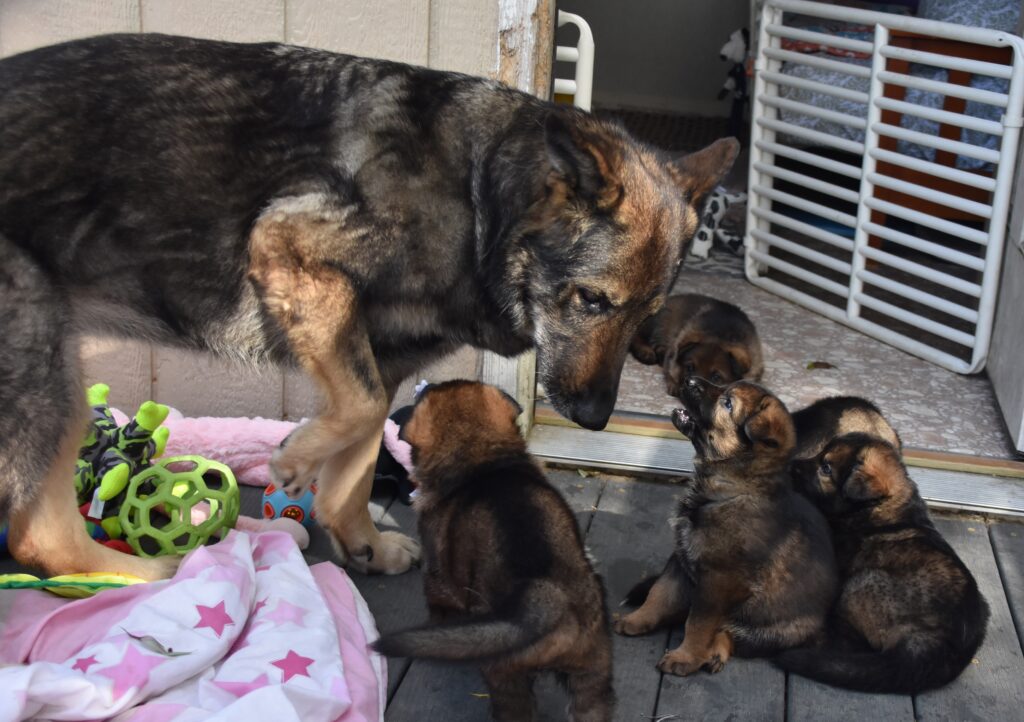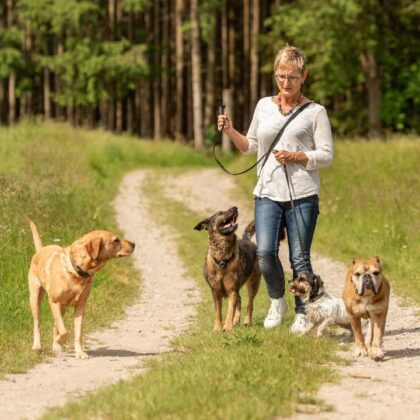
How does it work, a life with so many dogs? At the moment, there is only 7, though we’ve had as many as 13 dogs. (We were younger then!) At the top of the chart is Flicker, who will be 14 in March 2024. Her great-granddaughter River will be a year old in May 2024.
How do I try to stay in balance with so many lives woven together? To be sure, I often lose my balance on this score as well as many others, but now sailing into my senior years, I’ve learned that this is just life in all its ups and downs. So while I keep seeking balance, I also accept that no matter what, balance will be lost at times for many reasons.
First, life with many dogs requires that I let go of the notion that I could possibly have the same kind of relationship with all the dogs that I could have with 1 or 2 dogs. It’s a lot like being married, and then being married with a kid, and then having 4 more kids (or in this case, a lot more after that!) It is more complex in some ways, less intense on some levels, more intense on others, and yet the shared interactions also lift the burden from my shoulders to be ALL.
When I had just one dog (a long, long time ago, Carruthers…), I was acutely aware that I was that dog’s whole world. If I wasn’t with him, he was alone. If I wasn’t able to play with him, he was alone, playing by himself or waiting for me. This is not true of my current gang of dogs. If I or John are unavailable or busy working, the dogs in today’s household can and do entertain themselves for hours on end with their own games in the yard and house – games that do not require a human, and are purely canine.
I am not their whole world – they have a rich social life. The mixture of ages helps a lot. The youngsters keep the old folks spry and on their toes, the elders teach the pups what good manners are, and the middle aged enjoy their status as in-the-know, physically at their peak and enjoying long established relationships with older dogs and learning about the younger dogs. It is a joy watching an older dog light up and teach the pup about playing catch-me-if-you-can, dialing down their speed and power to be suitable for a youngster.
I never allow other dogs to fill in the gaps in a relationship between me and a dog. This is deliberate on my part. It’s all too easy for dogs to become more attached to other dogs than to people. Why? Sometimes, it’s because dogs are better playmates for dogs than boring, clumsy, demanding or unaware people. If those other dogs are the primary source of fun, interactions, learning, companionship, etc. we cannot be surprised when the dogs tell us what matters more to them. While I leave a dog free to learn from and teach the others, I am aware that this does not build my relationship with that dog.
I do not separate a puppy from the adults other than to limit inappropriate exercise or activities. I do not worry about the time they spend with other dogs. I know that some trainers are vehement about limiting or completely avoiding play with other dogs in order to make sure all fun/learning come from the handler alone. To my way of thinking this approach is abhorrent and unnatural. This is as ludicrous as saying my best friend is my best friend because she isn’t allowed to have any other friends.
Instead, I make sure that my relationship with any individual dog is intense, pleasurable, and rewarding for that dog. I commit to investing myself completely in being connected with that dog in that moment. In other words, what the dog gets from being with me is different from what he can get from another dog or any other person for that matter.
I remain alert to what each dog tells me about what they need. Just as a friend might call or show up and need my attention to varying degrees, so do the animals – and I do my best to respond according to what they say they need. More often than not, they don’t need anything extravagant or time consuming – just a genuine moment of connection. Make no mistake about it: genuine is key. Dogs don’t appreciate disengaged “yes dear” conversations any more than we do.
Doing this with many dogs sounds nearly impossible, and yet, each dog has different needs. Various ages, various personalities, various stages of experience and training . . . all make for different demands on me from each dog. Thus, I can juggle it all. Some days better than others.
A walk with an elder dog offers something different than taking a puppy out into the world. The joys of a fresh young body and an open mind is a welcome relief from caring for an aging senior who is more fragile and limited. Could I deal with a dozen 9 month old puppies? No way! Could I deal with a dozen 14 year old dogs? Maybe, but keeping track of that many elderly canines and worrying if they were sleeping deeply or maybe just not breathing would probably kill me!
So, how do YOU juggle your multi-dog household? What’s most challenging? What’s the biggest benefit?

